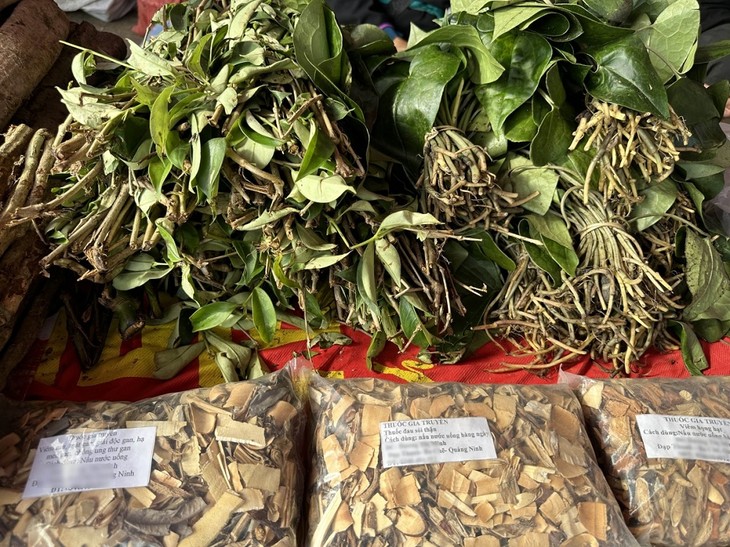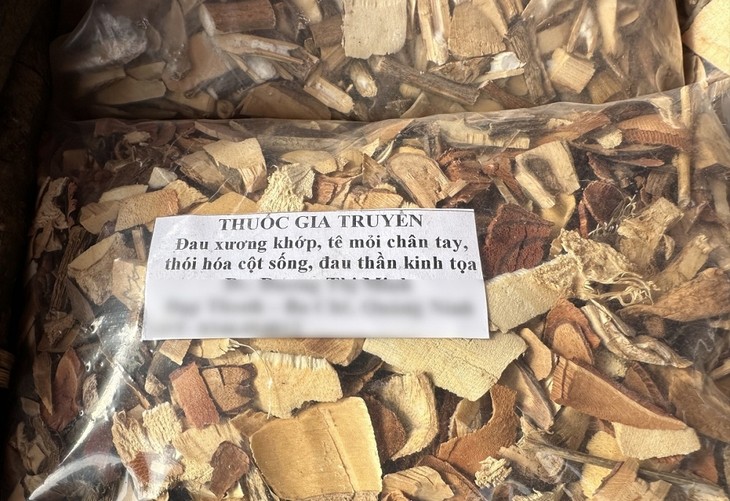(VOVWORLD) - For generations, the Tay ethnic people have known how to use forest leaves and herbs for medicinal purposes. Medicinal plants are found anywhere, from the edge of the village to the middle of the forest. But the Tay in each region have different ways of combining the plants to create a remedy. For the Tay in Ba Che district, Quang Ninh province, making medicines from plants is a recognized profession.
 Natural medicinal herbs are gathered from the forest. Natural medicinal herbs are gathered from the forest.
|
Every Tay person in Ba Che knows a few of the medicinal plants commonly used to treat illnesses. They teach each other about medicinal plants whenever they go into the forest. Those with the best understanding of medicinal plants can prescribe cures.
Duong Thi Minh of Dap Thanh commune has been making herbal medicines for 30 years. When she was little, Minh went with her grandparents and parents into the woods to look for medicinal plants, so she learned to recognize them. After she got married, she had more opportunities to learn because her in-laws are herbalists. Minh says each of her remedies combines multiple herbs.
“This is ‘trau tien’ or asarabacca, which can treat bone and joint pain, stomach ache, diarrhea, and coughs,” she told VOV, adding, “This medicinal plant helps bone fractures heal quickly. If it’s boiled in water to make a tea, it can help the elderly and children quickly recover from anorexia and asthenic conditions.”
Every day she gathers a few types of medicinal herbs, said Minh. Some are dried for later use, while others must be used fresh to maximize their medicinal effects. There are many types of medicinal plants in nature, but it takes experience to combine them into effective remedies.
According to Minh, medicinal plants are found in many places, even close to home. But there are some types you have to go deep into the forest to find. “I’m willing to share my remedies with other villagers, but many people say they can’t remember all the plants I’ve shown them. Some remedies only require one type of plant, but some require combining hundreds of herbs. That’s why people come to me for medicines,” said Minh.
 Mrs. Duong Thi Minh’s traditional remedies are made from medicinal herbs. Mrs. Duong Thi Minh’s traditional remedies are made from medicinal herbs. |
After working as an herbal healer for decades, Minh has lost track of how many people she has cured. She only knows she has followed her heart and helped as many people as possible. Her herbal medicines are widely known. She has clients from Bac Giang to Bac Ninh, Lang Son, and even provinces in the central and southern region.
Now at the age of 70, Minh wants to pass her knowledge on to her children and grandchildren. Her daughter, Ninh Thi Thang of Minh Cam commune, said, “Although my mother has showed me lots of medicinal plants, I can’t remember all of the family’s traditional remedies. I only remember the herbs used to cure a few diseases. I need to learn more about which plants cure which diseases before I start prescribing remedies.”
Ba Che, a district in northeastern Quang Ninh province, has high mountains where many rare medicinal herbs grow naturally. 30 of the 1,000 plant species identified in Ba Che have high medicinal value. These include Ba Kich (morinda officinalis), yellow flower tea, and green ironwood mushroom. From these rare medicinal herbs, the Tay create many remedies, says Tran Thi Cuu of Bac Xa village, Dap Thanh commune.
Cuu said she sells various types of medicinal plants. One is morinda officinalis. She has to go into the forest to gather these plants. “Each one has a variety of uses. Some plants are decocted for drinking. Others are used for medicinal baths. My customers in the lowlands often order my medicinal herbs by phone and ask me to send them by post,” Cuu noted.
The traditional herbal remedies of the Tay people in Ba Che district – and other ethnic minorities in Quang Ninh province – play an important role in their lives, curing their illnesses, boosting their incomes, and encouraging them to conserve the forest and its natural resources.